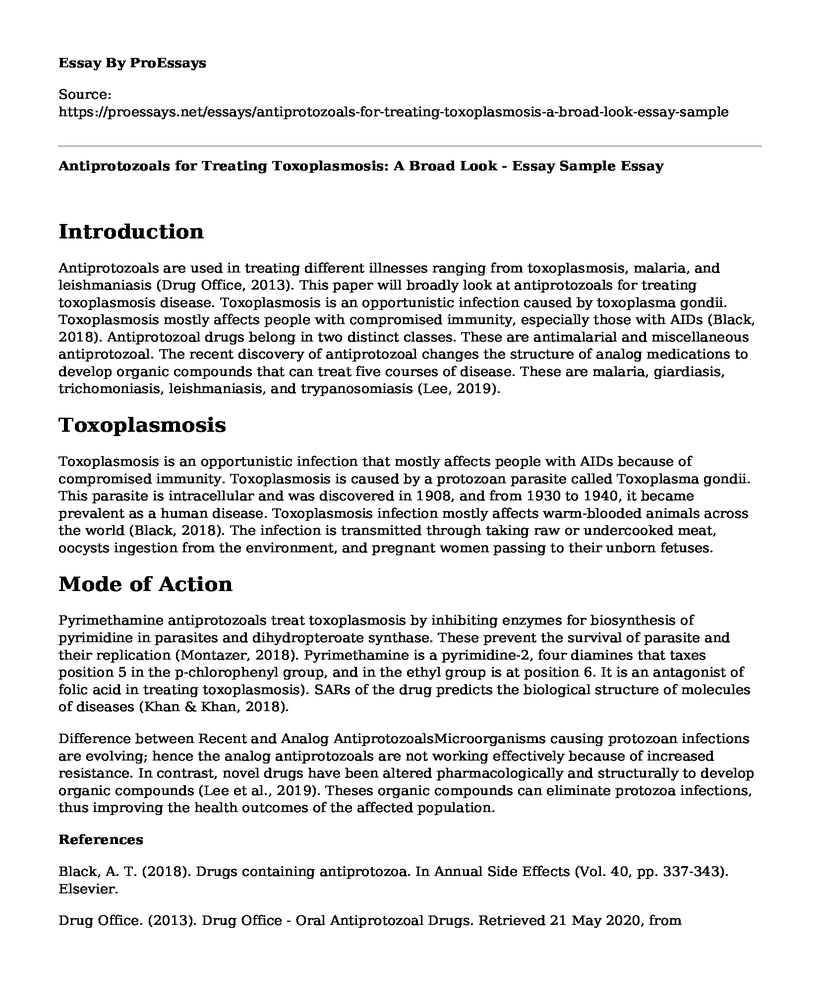Introduction
Antiprotozoals are used in treating different illnesses ranging from toxoplasmosis, malaria, and leishmaniasis (Drug Office, 2013). This paper will broadly look at antiprotozoals for treating toxoplasmosis disease. Toxoplasmosis is an opportunistic infection caused by toxoplasma gondii. Toxoplasmosis mostly affects people with compromised immunity, especially those with AIDs (Black, 2018). Antiprotozoal drugs belong in two distinct classes. These are antimalarial and miscellaneous antiprotozoal. The recent discovery of antiprotozoal changes the structure of analog medications to develop organic compounds that can treat five courses of disease. These are malaria, giardiasis, trichomoniasis, leishmaniasis, and trypanosomiasis (Lee, 2019).
Toxoplasmosis
Toxoplasmosis is an opportunistic infection that mostly affects people with AIDs because of compromised immunity. Toxoplasmosis is caused by a protozoan parasite called Toxoplasma gondii. This parasite is intracellular and was discovered in 1908, and from 1930 to 1940, it became prevalent as a human disease. Toxoplasmosis infection mostly affects warm-blooded animals across the world (Black, 2018). The infection is transmitted through taking raw or undercooked meat, oocysts ingestion from the environment, and pregnant women passing to their unborn fetuses.
Mode of Action
Pyrimethamine antiprotozoals treat toxoplasmosis by inhibiting enzymes for biosynthesis of pyrimidine in parasites and dihydropteroate synthase. These prevent the survival of parasite and their replication (Montazer, 2018). Pyrimethamine is a pyrimidine-2, four diamines that taxes position 5 in the p-chlorophenyl group, and in the ethyl group is at position 6. It is an antagonist of folic acid in treating toxoplasmosis). SARs of the drug predicts the biological structure of molecules of diseases (Khan & Khan, 2018).
Difference between Recent and Analog AntiprotozoalsMicroorganisms causing protozoan infections are evolving; hence the analog antiprotozoals are not working effectively because of increased resistance. In contrast, novel drugs have been altered pharmacologically and structurally to develop organic compounds (Lee et al., 2019). Theses organic compounds can eliminate protozoa infections, thus improving the health outcomes of the affected population.
References
Black, A. T. (2018). Drugs containing antiprotozoa. In Annual Side Effects (Vol. 40, pp. 337-343). Elsevier.
Drug Office. (2013). Drug Office - Oral Antiprotozoal Drugs. Retrieved 21 May 2020, from https://www.drugoffice.gov.hk/eps/do/en/consumer/news_informations/dm_20.html#b
Lee, S. (2019). Recent Advances in the Discovery of Novel Antiprotozoal Agents. Journal of Molecules, 24(21), 3886.Montazer, M. (2018). Drug resistance in Toxoplasma gondii. Frontiers in microbiology, 9 (3), 2587.
Khan, K., & Khan, W. (2018). Congenital toxoplasmosis: An overview of the neurological and ocular manifestations. Parasitology international, 67(6), 715-721.
Cite this page
Antiprotozoals for Treating Toxoplasmosis: A Broad Look - Essay Sample. (2023, Aug 10). Retrieved from https://proessays.net/essays/antiprotozoals-for-treating-toxoplasmosis-a-broad-look-essay-sample
If you are the original author of this essay and no longer wish to have it published on the ProEssays website, please click below to request its removal:
- Hursthouse, Conservative View
- The Process of Nurturing the Infants: Creating Space for the Baby Essay
- Essay Sample on Rubella/German Measles
- Healthcare Ethics: Tonya Archer's Case Study
- Essay Example on Modern Birth Control: Hormonal Contraception and its Benefits
- Essay on Urban Governance: Examining Diffuse Authority & Unspoken Conventions
- Paper Example on Psychiatric Assessment: Finding the Right Treatment Plan







